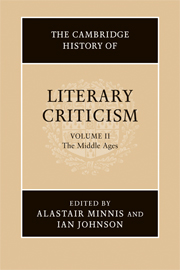Book contents
- Frontmatter
- Introduction
- I THE LIBERAL ARTS AND THE ARTS OF LATIN TEXTUALITY
- II THE STUDY OF CLASSICAL AUTHORS
- III TEXTUAL PSYCHOLOGIES: IMAGINATION, MEMORY, PLEASURE
- IV VERNACULAR CRITICAL TRADITIONS: THE EARLY MIDDLE AGES
- 9 Medieval Irish literary theory and criticism
- 10 Anglo-Saxon textual attitudes
- 11 Literary theory and practice in early-medieval Germany
- 12 Literary criticism in Welsh before c. 1300
- 13 Criticism and literary theory in Old Norse-Icelandic
- V VERNACULAR CRITICAL TRADITIONS: THE LATE MIDDLE AGES
- VI LATIN AND VERNACULAR IN ITALIAN LITERARY THEORY
- VII BYZANTINE LITERARY THEORY AND CRITICISM
- Bibliography
- Index
- References
12 - Literary criticism in Welsh before c. 1300
from IV - VERNACULAR CRITICAL TRADITIONS: THE EARLY MIDDLE AGES
Published online by Cambridge University Press: 28 March 2008
- Frontmatter
- Introduction
- I THE LIBERAL ARTS AND THE ARTS OF LATIN TEXTUALITY
- II THE STUDY OF CLASSICAL AUTHORS
- III TEXTUAL PSYCHOLOGIES: IMAGINATION, MEMORY, PLEASURE
- IV VERNACULAR CRITICAL TRADITIONS: THE EARLY MIDDLE AGES
- 9 Medieval Irish literary theory and criticism
- 10 Anglo-Saxon textual attitudes
- 11 Literary theory and practice in early-medieval Germany
- 12 Literary criticism in Welsh before c. 1300
- 13 Criticism and literary theory in Old Norse-Icelandic
- V VERNACULAR CRITICAL TRADITIONS: THE LATE MIDDLE AGES
- VI LATIN AND VERNACULAR IN ITALIAN LITERARY THEORY
- VII BYZANTINE LITERARY THEORY AND CRITICISM
- Bibliography
- Index
- References
Summary
The majority of the Welsh poems extant from the medieval period were composed by praise-poets for oral performance at courts, religious foundations and noble houses. While the standing and livelihood of the poets depended mainly on their effectiveness in ‘making fame’ and on their technical ability, they also felt the need to explain and promote themselves, both as representatives of an august, ancient and autonomous bardic order, and as individuals vying for favour and position. These reflections, frequently conventional, are embedded in the verse, and in the absence of any treatise on Welsh poetics before the bardic grammar of the early fourteenth century, they are a guide to the practitioners’ conception of their work. A corresponding emphasis on the poetic self, vis-à-vis the heavenly Patron, is evident in the religious poetry. Poems in the personae of the prophet Myrddin and especially the primordial poet and sage, Taliesin, are a subsidiary source, dramatic and perhaps archaising, which detail concerns such as inspiration, performance, competition, poetic worth and aesthetic criteria, and contain many technical terms. Prose criticism, by contrast, is minimal: native texts before c. 1300 are all anonymous and lack prologues, although they are usually assigned a name and a type in brief concluding colophons, which in rare cases elaborate on the nature of the text. Explicit translation theory is poorly attested, and must be inferred from working practice.
- Type
- Chapter
- Information
- The Cambridge History of Literary Criticism , pp. 333 - 344Publisher: Cambridge University PressPrint publication year: 2005



